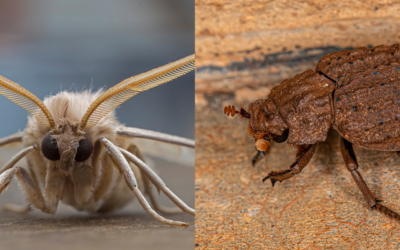Identification and Prevention
Invasive moths are an absolute nightmare. And that nightmare will only worsen after you realize that you used a deterrence against another species. Learning to distinguish between the clothes moth and the pantry moth will help determine which one is bugging you, how to prevent it, and what to do if you have an infestation.
What are the main differences between clothes and pantry moths?
It is important to distinguish between the clothes moth and the pantry moth to know how to treat and prevent the problem from recurring. Clothes moths tend to stay in one place and may not be seen until you go into your closet.
A pantry moth infestation will be noticed more quickly because they take residence in your pantry or cupboards and feed on dry ingredients. In addition, they are more likely to fly around looking for food sources.
What does a clothes moth look like?
There are two types of clothes moths: webbing moths and casemaking moths. These moths are tiny, less than a half-inch long in most cases. The main defining feature between the two is their color. The webbing moth is solid whitish-gray, while the casemaking moth has brown or gray spots on its wings. Both have narrow, hairy wings. The clothes moths will avoid light and are weak fliers, so they tend to stay in one place to lay their eggs and feed.
What does a pantry moth look like?
Pantry moths, also known as Indianmeal Moths, are also small, usually around a half-inch long, with a wingspan around 5/8 of an inch. They are yellow-gray, with reddish-brown or dark-gray wings. A distinguishing trait of the pantry moth is a black band that sits between the upper and lower segments of its body.
What do clothes moths eat?
Adult moths do not feed on fabrics and upholstery; that is the work of clothes moth larvae. This is because adult clothes moths do not have mouths. However, the larvae are attracted to natural fibers found in clothing, such as silk, wool, and cotton, that contain a protein called keratin, which is found in natural fibers and hair.
They will also feed on carpet, upholstery, and curtains. On occasion, you may discover that they have fed on synthetic materials as they were looking for those natural fibers. They are especially attracted to fabrics that contain body oils, urine, or food stains.
What do pantry moths eat?
Pantry moths will take residence in your kitchen, where they will have a constant food source from your pantry and cupboards. They feed on dry food such as pasta, cereal, oatmeal, flour, and bread. Sometimes they will even feed on dry pet food, dried fruits, processed snacks, and birdseed.
How do clothes moths get into your home?
Clothes moths gain entry when you bring used clothing, furniture, or rugs into your home. They often come in with stored items that have been kept in garages or sheds. They are small enough to squeeze through cracks and crevices around doors and windows or just fly in when they are open.
How do pantry moths get into your home?
The pantry moth almost always gets inside houses through contaminated dry foods. They can also enter through open doors and windows, using their sense of smell to find a meal and lay eggs. Your kitchen is the ideal location. Pantry moths can also come through openings around plumbing lines, cables, and dryer vents.
How to prevent a clothes moth infestation
It is crucial to inspect second-hand items you bring into your home thoroughly. It is also a good idea to properly clean these items, especially if you plan for them to be stored away in a closet or storage area for an extended amount of time.
To help prevent an infestation, clean and vacuum in and around areas that contain natural fibers. Regular cleaning of dust, hair, and lint build-up also helps. In addition, using a natural moth repellent, such as hand-washing your garments in lavender oil or cedarwood rings in your closet or drawers, are a good deterrent.
How to prevent a pantry moth infestation
The best way to prevent an infestation of pantry moths is to keep stored food in airtight containers. Another prevention method is to vacuum and wipe down pantry shelves regularly and inside cupboards. It is also important to check your cupboards and pantries for cracks and seal any openings.
If all else fails or the problem has gotten out of control, call the pest control professionals at 855Bugs to schedule a free inspection.


